Antinol® Latest Studies
Sorted by recent
 Filter Studies by Smart Tags
Filter Studies by Smart Tags
Bone & JointCardiovascularCase StudyCatDogEAB 277™EfficacyExotic PetImmunologyNeuro & BehaviorOphthalmologyOralRabbitRenalRespiratoryRodentSafetySkinUTI
Smart Search
Efficacy of PCSO-524® and prednisolone combination treatment for neck pain in Chihuahua dog with Chiari-like malformation and syringomyelia

A 18-month-old male intact chihuahua presented with recurrent neck pain within 3 months after stop using prednisolone.
Upon physical and neurological examination, dog displayed pain and neck stiffness without neurological deficits. Radiographic findings of cervical spine was normal.
The dog was treated with prednisolone to relieve pain and inflammation and showed improvement of clinical signs. However, the recurrence occurred in 7 months with more severity. Magnetic resonance
imaging (MRI) demonstrated Chiari-like malformation and syringomyelia at C2-C4 and C7-T1 region.
PCSO-524® (VetzPetz Antinol®) was administered in combination with prednisolone and gabapentin. The clinical signs improved in 2 weeks so prednisolone was gradually reduced until discontinued but dose of PCSO-524® remained constantly. The dog was able to recover from neck pain and continued life activities as normal.
Long-term supplement of PCSO-524® (VetzPetz Antinol®) was effective for reducing inflammation of spinal cord in dog suffered from neck pain caused by syringomyelia.


Use of PCSO-524® for Treatment of Spine Fracture in Conjunction with Pedicle Screw-Rod Fixation (PSRF)

An intact male mixed breed dog aged 2 years engaged in a fight with several dogs resulting in disable of hind limbs and loss control of elimination. Physical and radiographic examination showed fracture and luxation of the 7th lumbar vertebrae. Spinal cord injury (SCI) was also found and the fracture was identified as the cause. The spinal cord trauma could occur since the incident and was left for more than 2 weeks.
Pedicle screw-rod fixation (PSRF) was operated to fix the vertebral column. After the second operation, it was suspected that there was remain of inflammatory cytokines that probably increased after the operation. Anti-inflammatory medication for prohibition of inflammatory cytokines synthesis was essential but its adverse effect must be concerned. The study therefore used holistic treatment including PSRF, non-steroidal drug and PCSO-524® anti-inflammatory extract, in conjunction with physical therapy.
Follow-up examination on neurological system, walking, and urinary system showed promising result. The neurological system was restored, and adverse effect of long-term use had not been found.

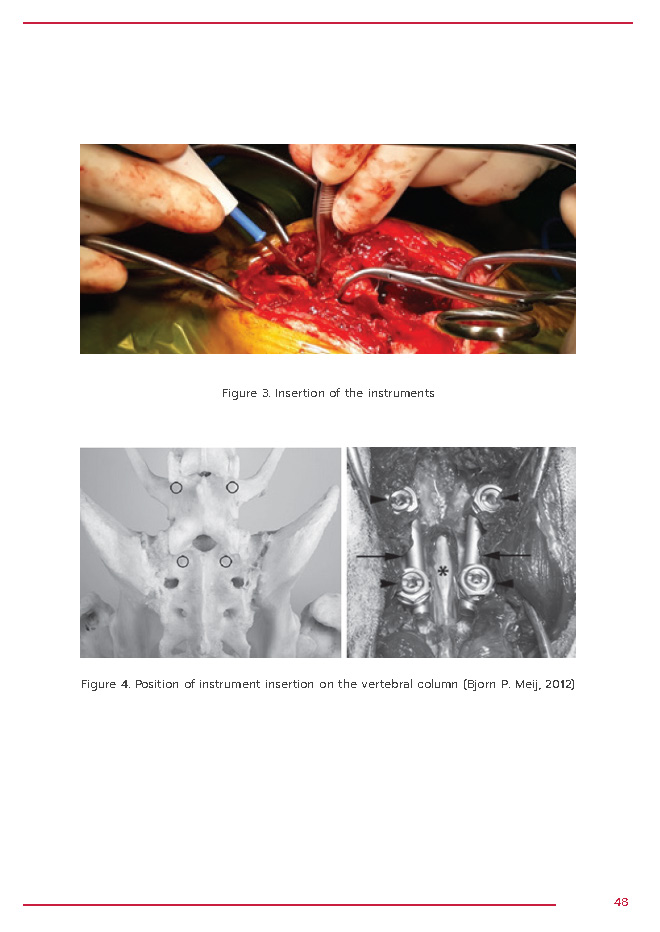
PCSO-524® Report Clinical Results of Nineteen Dogs with Tracheal Collapse that received PCSO-524®, a Lipid Extract of the New Zealand Green-Lipped Mussel (Perna canaliculus)

Case: Nineteen dogs presented with cough and diagnosed with tracheal collapse based on inspiration / expiration chest radiography between December 2013 and April 2015.
Tracheal collapse is a respiratory disorder characterized by the decrease of supporting force of the tracheal cartilage which results in abnormal dilating and flattening of the trachea. It is common in small-breed dogs and brachycephalic dogs. Tracheal collapse results from a number of causes including genetic factors, obesity, tracheal cartilage degeneration, chronic bronchitis, respiratory infection, and cardiovascular dysfunction. The combination with these causes worsens symptoms.
Comprehensive management is required such as medical treatment as well as surgical treatment at the time of progression.
This report summarize positive effects of PCSO-524® (Antinol®), a supplement product which includes anti-inflammatory fatty acids extracted from Perna canaliculus, another kind of green-lipped mussels, given to dogs with tracheal collapse.

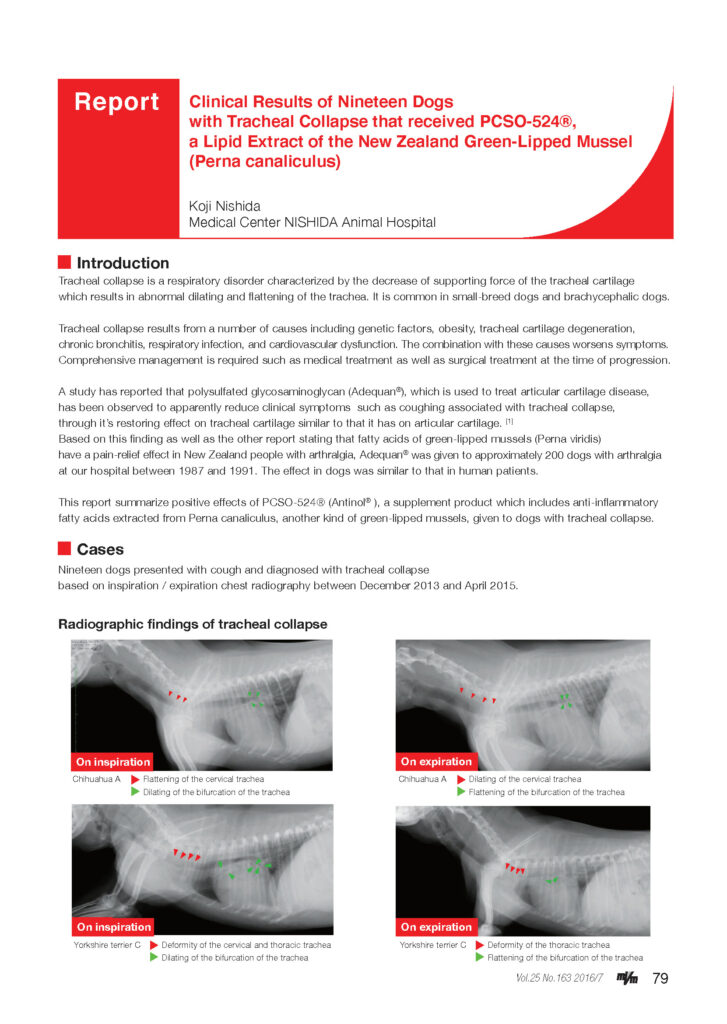


A Study of Efficacy and Safety
of PCSO-524® (Antinol®) in Treatment of Medial Patellar Luxation and Cranial Cruciate Ligament Rupture in a Yorkshire Terrier Dog

Male Yorkshire terrier dog aged 7 years weight 2.5 kg suffered from lameness of left Hind limb.
Examination found medial patellar luxation of grade 3 and chronic cranial cruciate ligament rupture.
PCSO-524® (Antinol®) 100 mg per day, double size of recommended dose for dogs weighed less than 20kg, was prescribed.
Examination of lameness score and pain on palpation showed improvement after PCSO-524® (Antinol®) treatment. Radiographic images taken before and after 45 days treatment with PCSO-524® (Antinol®) did not find progress of the lesion.
Hematological and biochemistry parameters after 45 days treatment with PCSO-524® (Antinol®) indicated that the medication was safe to use.
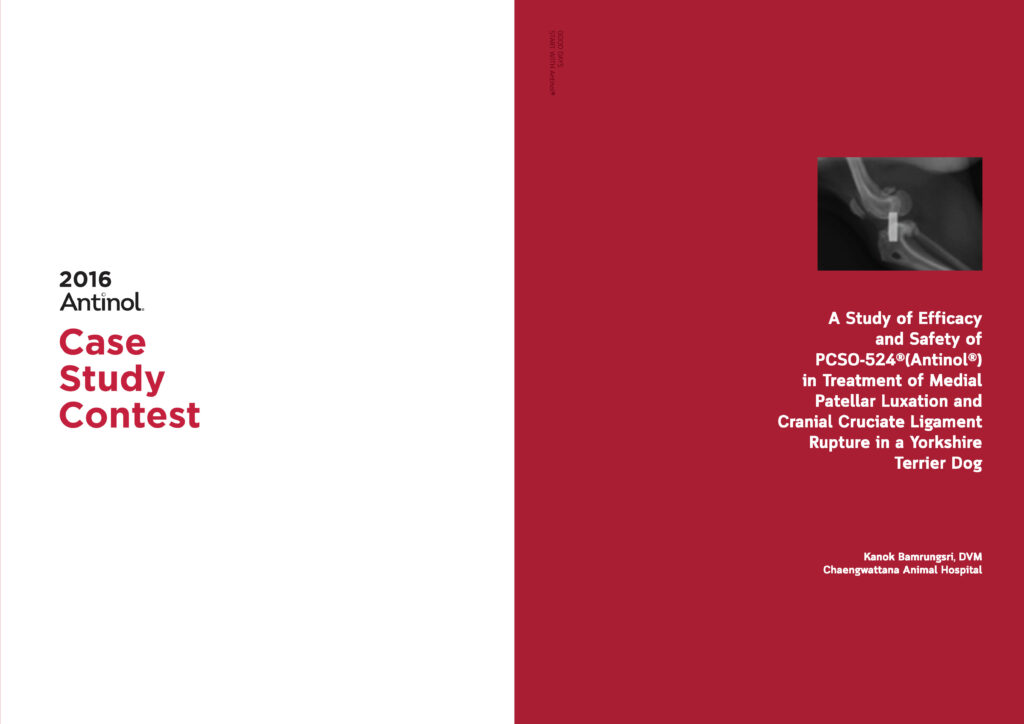
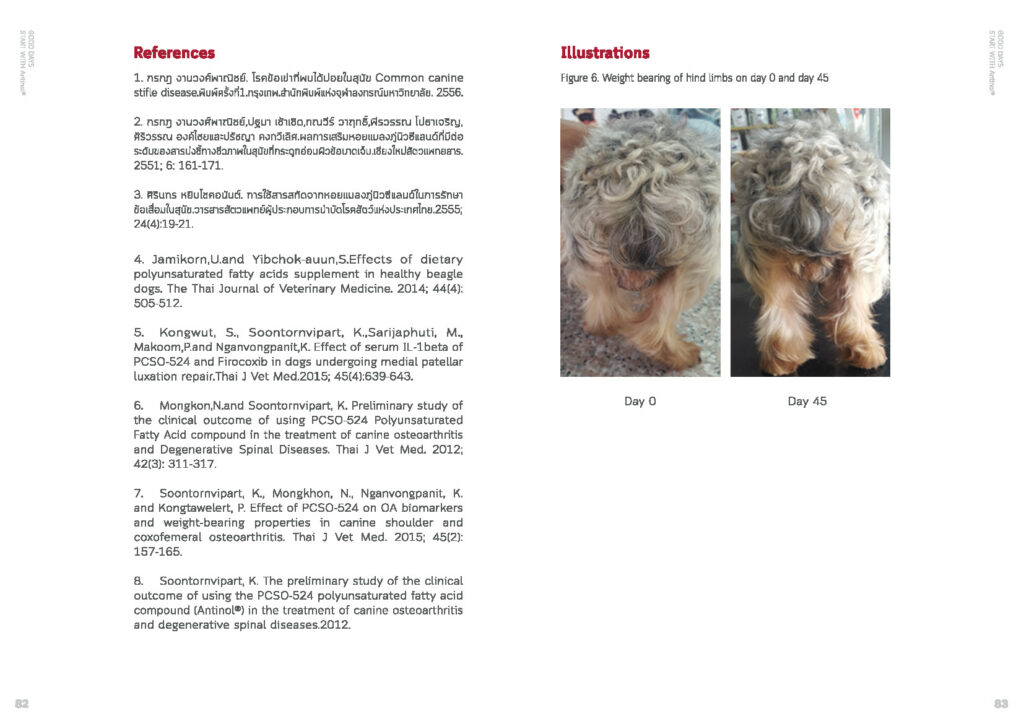
The Treatment of Medial Coronoid Disease in a Seven Months Old Labrador Retriever

Labrador retriever dog aged 7 months with history of right forelimb pain for 1 month was diagnosed as Medial Coronoid Disease (MCD) on both sides.
Radiographic and Computed Tomography (CT) examinations found subtrochlear sclerosis on left elbow. Arthrotomy was operated on the dog using subtotal coronoid ostectomy technique on the medial side of both elbows. Long-term treatment included physical rehabilitation, and nutrition therapy including administration of PCSO-524® and glucosamine/chondroitin sulfate. The dog was followed-up for 6 months for orthopedic examination and assessment by force plate gait analysis.
Two months after the operation, right forelimb could bear body weight, however left forelimb was still lame with lameness score of 1/4. Comparison of radiographic image showed that the left and right elbow was affected from moderate and mild osteoarthritis, respectively. Treatment success for MCD depends on early and accurate detection of the disease and appropriate treatment plan.
Multimodal plan consisting of surgical treatment, medication, nutrition therapy and physical rehabilitation, is proposed.
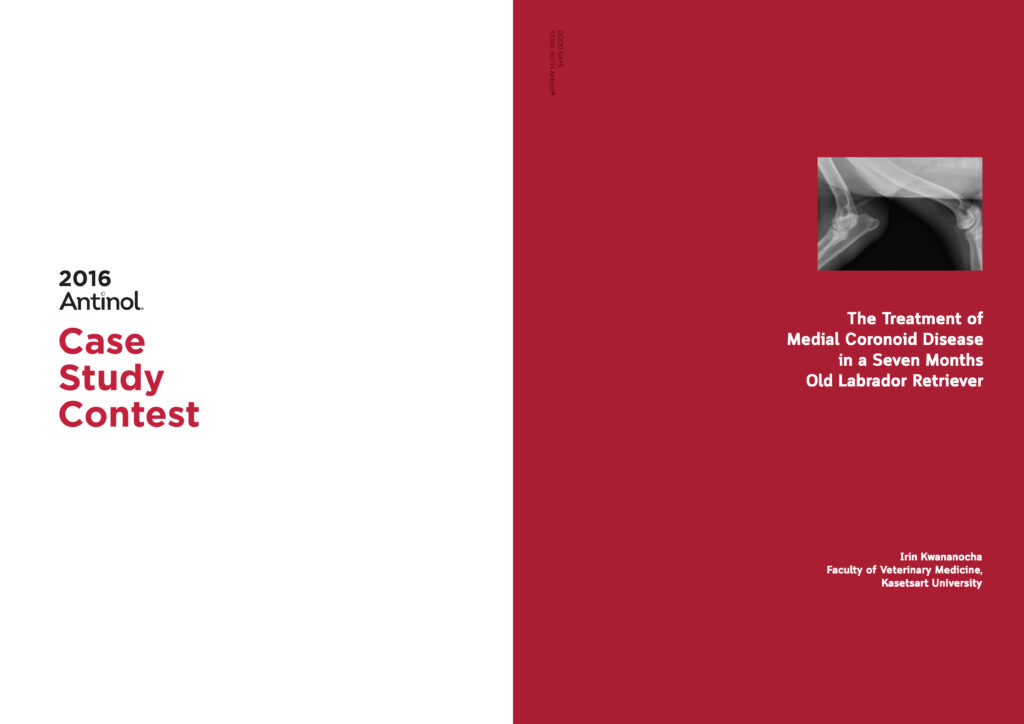

Effects of PCSO-524® on Treatment of Cranial Cruciate Ligament Rupture in Dogs after Tibial Plateau Leveling Osteotomy (TPLO) and Physical Rehabilitation

Male Labrador Retriever dog aged 3 years was suffering from left hind limb pain.
Hematological parameters were normal. Radiographic image showed swollen left stifle joint and mild osteoarthritis. Cranial cruciate ligament rupture was diagnosed.
Firocoxib 5 mg/kg sid for 2 weeks and 2 capsules of ANTINOL ® bid for 1 month were prescribed.
Tibial Plateau Leveling Osteotomy (TPLO) was operated on the dog. Post operation care included Firocoxib 5 mg/kg sid for 2 weeks and 2 capsules of ANTINOL ® bid in combination with physical rehabilitation using laser stimulation and later exercise therapy was added. Clinical signs were improved as indicated by lameness score, muscle mass and range of motion.
Five months after the operation, the dog expressed signs of right hind limb pain and radiographic image showed swollen right stifle joint and mild osteoarthritis of left stifle joint. Partial tear of cranial cruciate ligament was diagnosed. The dog was treated for thrombocytopenia until recovered before Tibial Plateau Leveling Osteotomy (TPLO) was operated on the right knee 3 months later. Radiographic examination post operation showed increased inflammation of both stifle joints.
Surgical treatment was used in combination with medication which included NSAIDs during the first 2 weeks post operation, ANTINOL®, and physical rehabilitation in order to reduce pain and inflammation. The treatment gave satisfactory results. The dog was able to use its legs without lameness, muscle was stronger, stifle angle was better and general health was improved.

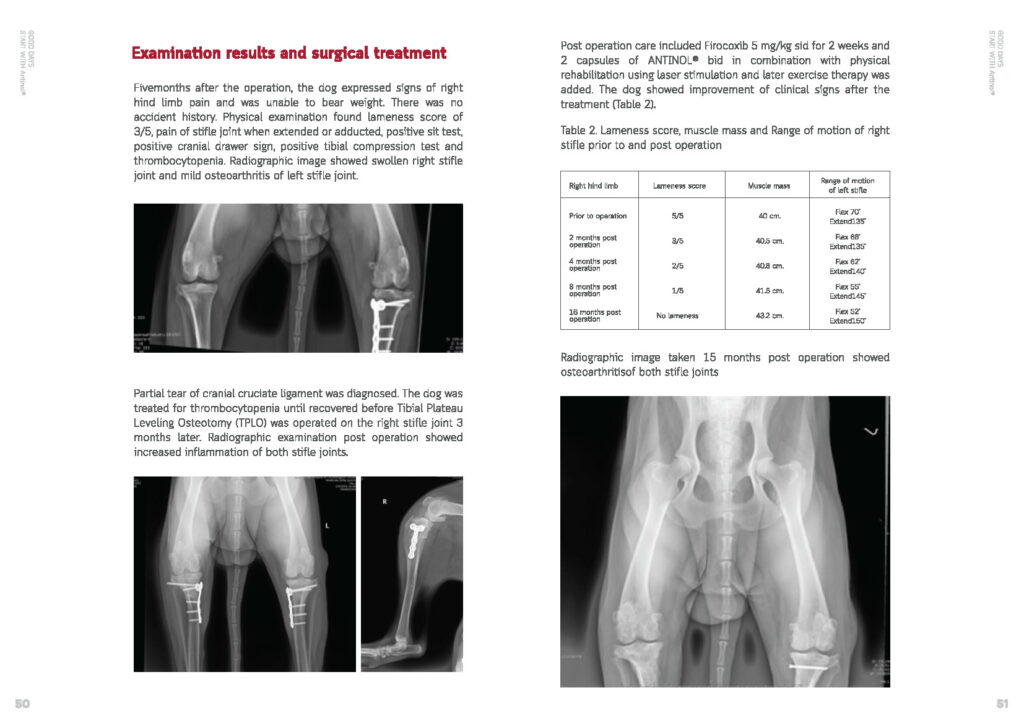
Use of PCSO-524® in Combination with Prednisolone for Treatment of Spinal Cord Injury from Disc Protrusion in Dogs

Male Shih tzu dog aged 9 years and 1 month was diagnosed with limb paralysis after jumping 4 days prior to the hospital visit.
The dog showed weak response of forelimb reflex and severe neck pain. X-ray examination showed block vertebrae at C3 and C4.
Magnetic resonance imaging (MRI) examination found mild disc protrusion, compression on spinal cord and myelopathy at C4 and C5 with compression on the right dorsal lamina.
Prednisolone and gabapentin were prescribed to reduce inflammation and pain, respectively.
Follow-up after reduction of prednisolone showed that the dog fell more often while walking and slight neck pain was present. Prednisolone dosage was then increased and PCSO-524® was prescribed to reduce inflammation of the spinal cord. Later examination found that the dog could walk without falling, both forelimbs showed normal reflex, and signs of neck pain disappeared. Termination of prednisolone was then started without any recurrent clinical signs.
After continuous treatment with PCSO-524® for 6 weeks, the dog could walk normally, both forelimbs showed normal reflex, and the ALK level was nearly back to the level prior to the treatment.
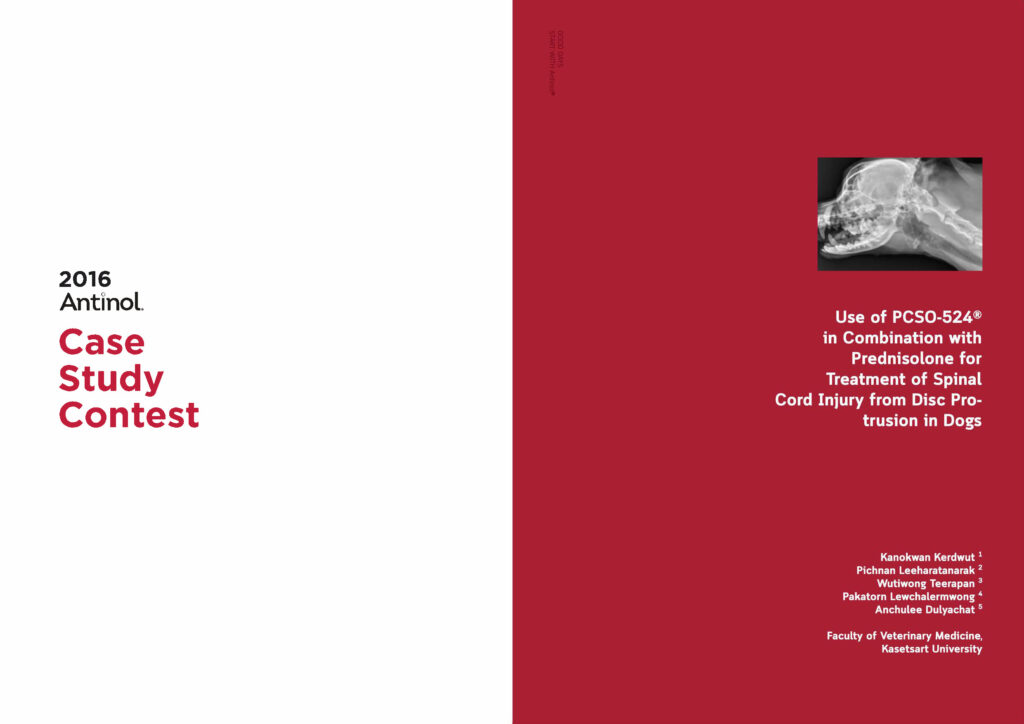
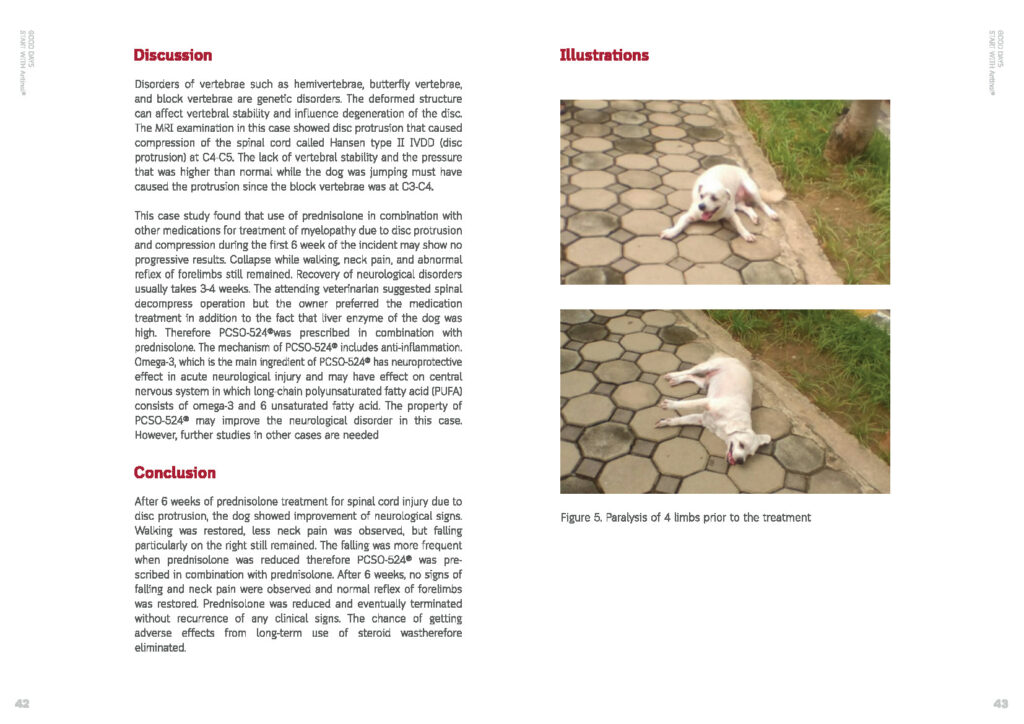
Effectiveness of Disease Modifying Osteoarthritis Agents and Carprofen for Treatment of Canine Osteoarthritis

A prospective, randomized, single-blinded study was conducted to evaluate and compare the effectiveness of disease modifying osteoarthritis agents (DMOAAs) and carprofen by using force plate gait analysis and orthopaedic assessment score (OAS) in osteoarthritic dogs.
Forty dogs with hip and/or stifle osteoarthritis (OA) were assigned randomly into four treatment groups:
PCSO-524, treated with a marine-based fatty-acid compound; GC-ASU, treated with a combination of glucosamine-chondroitin sulphate and avocado/soybean unsaponifiables; CPF, treated with carprofen; and CPF-PCSO, treated with a combination of carprofen and PCSO-524. Each group received the therapeutic agent orally for four weeks.
Peak vertical force (PVF), OAS, haematology and blood chemistry values were evaluated before treatment, and on the second and fourth weeks post-treatment.
No significant effect was found in the PVF, OAS and blood values among the four treatment groups.


Effect of PCSO-524 on OA Biomarkers and Weight Bearing Properties in Canine Shoulder and Coxofemeral Osteoarthritis

This trial included 66 mixed breed dogs with x-ray confirmed OA split into two treatment groups for 24 weeks. These were 1) PCSO-524 (5 mg/kg) and 2) fish oil (2,000 mg/d). The dogs were all placed on a standardised diet to minimise variability.
The results suggest that PCSO-524 is protective against cartilage breakdown in dogs with osteoarthritis.


The Effectiveness of Marine Based Fatty Acid Compound and NSAIDs for the Treatment of Canine Osteoarthritis: a preliminary study

The Objectives of this study were to investigate the effectiveness of PCSO-524, NSAIDs and combination of NSAIDs and PCSO-524 in the treatment of canine osteoarthritis through the use of force plate gait analysis.
Study Design: A prospective block-randomized single-blinded study.
Animals: Thirty client-owned dogs that had clinical and radiographic evidences of hip or stifle osteoarthritis.

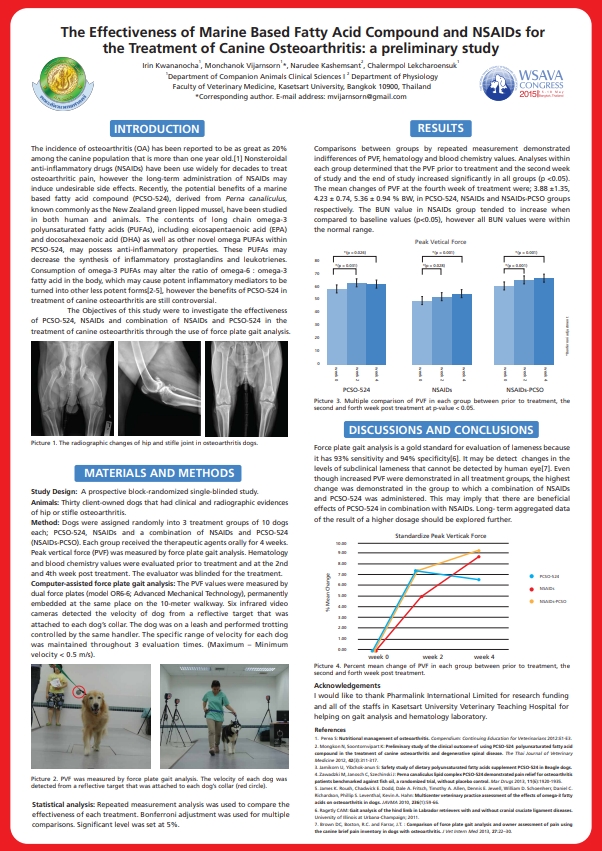

Updated Study Topics
New researches and publications related to PCSO-524® and its result in clnical test submitted by veterinarians on the global conferences every year and the data keeps growing with more studies conducted


 Authors:
Authors: